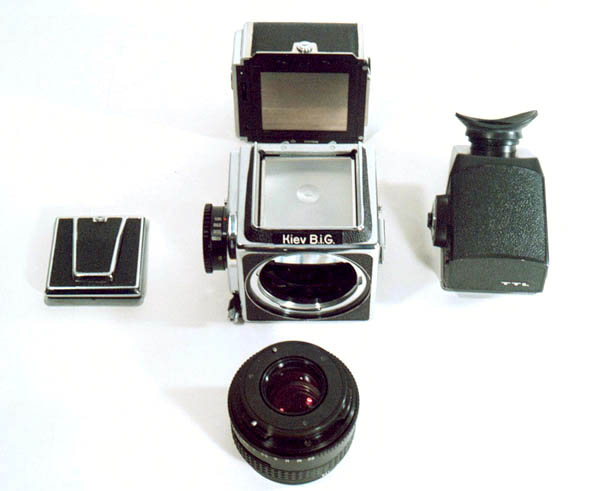The Kiev B.i.G.
A review written in
1998
by TRA
The
basic concept
 [C213-10: The modular system: at its heart,
a box containing
a shutter.
[C213-10: The modular system: at its heart,
a box containing
a shutter.
Here we can also see a film back, a standard lens, and
two viewfinders:
the waist-level finder (on the left)
and the TTL Cds metering prism finder on the right).]
|
|
The Kiev 88/Kiev B.i.G. is a modular camera. At
its heart is
a body consisting of a mirror box with a ground-glass
screen and a focal-plane
shutter providing speeds from ˝ to 1/1000 sec plus B, with
controls
to cock and fire the shutter. To this box must be
added a lens, a
film magazine, and a viewfinder. This results in an
extremely flexible
piece of equipment that is quite different in shape from
the 35mm SLRs
that have dominated the market for serious amateurs
world-wide for decades.
The minimum configuration usually supplied includes the
three essential
additional components:
-
an 80mm f/2.8 multi-coated lens with an automatic
diaphragm;
-
a magazine (or “back”, in the jargon) for 120 film,
producing 12 nominally
6 x 6 cm frames (actually 56mm x 56mm, the
international standard size);
-
a waist-level or prism viewfinder.
In practice, the camera is often supplied with two 6x6
magazines and two
viewfinders: the waist level finder and a TTL Cds metering
pentaprism. |
A wide range of lenses is available, from a 30mm fish-eye to two
different
250mm lenses, as well as a 2x converter, and in addition to the
standard
film magazine, there is a “645” magazine that delivers 16 images
nominally
6 x 4.5 cm on 120 film, and that accessory much-demanded by
professionals,
a Polaroid back that enables the user to check on lighting and
exposure
before completing an assignment on negative or slide film.
The concept, which is alleged to date back to German designs
obtained
by the Allied Powers at the end of the Second World War, is
brilliant.
It has been further refined and improved by the Swedish firm of
Hasselblad
over the past fifty-plus years. The implementation by the
Arsenal
Works has been less successful, largely because of the apparent
non-existence
of quality controls at the factory, and the consequent release
onto the
market of faulty and unreliable equipment in large numbers.
However,
since the sixties, the message has always been, “if you get a good
one,
it lasts forever.”
To go on to the next section, click below.
Next section (How is the Kiev B.i.G.
better?)
To go back to the beginning of the Kiev B.i.G. review, click
below and
then choose the section that you want to read about.
Back to beginning of the Kiev B.i.G. review
Home
© TRA February 2002, November 2005 Minor formatting
improvements: November 2018
